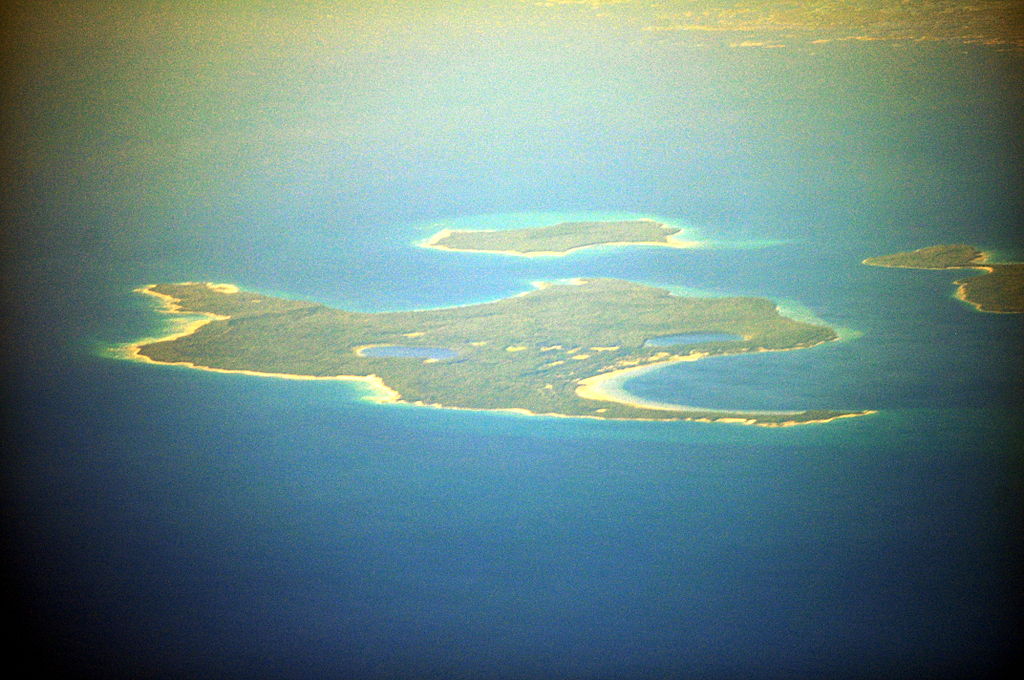 The 17th century hangs heavy over the ‘heartland’ of Georgian Bay, the twin peninsula to ‘the Bruce’ to the west. Both, of course were the home of natives, who were forced to cede about 98% of their land to the white settlers in the 18-19th cc. Even much of whatever shoreline is in the remaining 2% was/ is leased to the present day colonists, who flock to the sandy shores in the summers. Georgian Bay’s history is a dramatic example of how this happened.
The 17th century hangs heavy over the ‘heartland’ of Georgian Bay, the twin peninsula to ‘the Bruce’ to the west. Both, of course were the home of natives, who were forced to cede about 98% of their land to the white settlers in the 18-19th cc. Even much of whatever shoreline is in the remaining 2% was/ is leased to the present day colonists, who flock to the sandy shores in the summers. Georgian Bay’s history is a dramatic example of how this happened.
The 17th century was the killer, literally. Measles, influenza and smallpox killed 15,000 of the 25,000 Hurons. The Iroquois, head of the confederation of five nations—Mohawk, Oneida, Onondaga, Cayuga and Seneca, sealed their fate, ‘winning’ the Beaver Wars throughout the St. Lawrence River valley and the lower Great Lakes region, killing most of the rest. But who ‘traded’ them guns for the (then) valuable furs to play the now lethal war games? The Dutch.
Unlike the British and French, the Dutch had no scruples about letting the natives kill each other. Mind you, the French and British had lots of guns, and used them to fight their native allies’ ‘enemies’, as proxies in the French-British wars. So Champlain teamed up with the Huron and Algonkin in 1615, and famously shot three Iroquois chiefs (British allies) in a battle near Lake ‘Champlain’ (south of Lake Ontario). This enmity culminated in the tragedy in 1649, when the Iroquois decimated 10,000 Huron and 8 priests at the Jesuit mission Sainte-Marie-au-pays-des-Hurons, where Midland stands today.
The conflict subsided with the loss by the Iroquois of their Dutch allies in ‘New Netherland’ (later lower New York State) after England took it over in 1664. Yikes! Suddenly the Iroquois were masters of a devastated land, cleared of their native ‘enemies’, so no longer of use to the British. The settlers had lots more guns and other secret weapons, and the Iroquois hold a place in history with the Epirians, whose king’s forces defeated the Romans in the battle of Asculum, but would soon be overwhelmed by the Romans. They won the battle, but lost the war.
There were less than 20,000 Iroquois for all five tribes in 1600. Their inland location protected them somewhat from the initial European epidemics, but these had reached them by 1650 and, combined with warfare, cut their population, like the Huron, to about half of its original number.* Today, there are 18,000 Iroquois vs 356,000 Cree, 170,000 Mi’kmaq and the Iroquois’ enemy, the Ojibwe 126,000.
Christian Island is home of what came to be called the BeauSoleil band. They are Ojibwe, and have 2,587 members, the on-reserve population 614. Natives no longer have the need to fight each other for control of furs or whatever. Now they live in peace with their cousins and their masters. On my bike trip through the peninsula (unnamed), centred now on Midland, a pokey town of 17,000 (100,000 in the cottage season), I visited their home base, Christian Island, at the tip of the peninsula.
Battle of religions
My base was the aptly named Midland.** After 5 hours upwind, uphill biking from Barrie to Midland on Day One, I found Eighth St, and my hosts’ home, right next door to The River of Life, clearly an Evangelical haunt. Some variant of Christianity is central to most small town Canadians, and natives are no exception. The beauty of native religions was suppressed with first the Jesuits, soon followed by Anglicans and Methodists (now United Church).
My host John and I bonded when I asked about the ‘river of life’. “I stopped going after I got in an argument with the pastor there. He’s big on Israel.” I concurred: “These evangelicals mean well, but they’re duped into this millennialism. ‘Let the Jews go to Israel and we’ll have the second coming.’ What kind of religion is that?” “Yes, it started with the Scofield Bible.” “You know about Scofield? I just happened to have written a book about ‘the Canada Israel nexus’. There are 100m Evangelicals in the US, ‘Christian Zionists’,” I shook my head in awe.
Day Two was a hard slog north along the ‘Penetanguishene Loop’, one of the bike trails sponsored by Tourism Simcoe County, who provide free bike route maps which I used as the inspiration for bike trips to Meaford in the west, and Orillia in the east. I then headed west, up Methodist Point road to Lafontaine, originally called Sainte-Croix, renamed to honour Louis-Hippolyte Lafontaine, one of the early Joint Premiers of the Province of Canada. Appropriately, a large cross looms over passing motorists. The Jesuit spirit of Sainte-Marie-au-pays-des-Hurons lives on.
Christianity hovers in the background in this backwater -- Catholic, Protestant and Evangelical. A nearby historic site, Carhagouha, marks the spot where an earlier Récollet missionary to Wendake, Fr. Joseph Le Caron, presided in 1615 over the first Catholic mass conducted in present-day Ontario. There were fresh flowers there. I'm not the only pilgrim in this neck of the woods.
My first real native acquaintance was thanks to John, who introduced me to Les. Les explained: “There are maybe half Catholics, half United up here. But the resurgence of pre-colonial ways of life is the goal of the ‘traditionals’, vs the government sanctioned band councils, and that has meant reviving native religion in place of Christianity. The residential schools were the last straw. So my Christianity doesn’t sit too well with them. But I argue that Jesus’s message was distorted when Christianity became the religion of empire. His message is much like the message in our traditional religion.”
I joined my couchsurfing hosts John and Lori in a potluck to celebrate the birthday of Les, né Leslie Ciphery, who is their boarder, and whose mother was Ojibwe, father Gaelic. Les is a soft-spoken, blond, 53 year old bachelor, who has had a tough life, but is resilient and intelligent. “I was taken from my mother soon after I was born. I never met her til I was 17. But thankfully, no residential schooling. My adoptive mother was raised in a convent, as she was illegitimate and was rejected. So she loved all kids, adopting 4 orphans to join her 4 birth kids. It was not easy for me as a ‘half-breed’. My siblings were standoffish, and at school I was victimized, but she did her best.”
Every native has some such sad story. Les managed to survive, working with drug-addicted teens at the Ojibwe band office at Rama, but left when cutbacks led the Ojibwe council to cut staff. As Les was only half native, he got the ax in favour of an unqualified ‘full blood’. Les has a truck license and figures he’ll take up driving again. “I got the worst of both worlds: looked down on by whites and traditionalists.”
Considering this is rich folks cottage country, and from my experience cycling where monster trucks hurled past when I used the highway, he should have no trouble. A hurricane devastated many cottages in 2010. Imagine the bitterness Les must transcend, maintaining his cheery demeanour, while working as slave labour to the latter day colonists to build yet more palaces, shamelessly flaunting their wealth. But for guys over 50, it is extra hard to find work, so he doesn't have much choice. Les is a devout (and articulate) Christian. His faith gives him a different language, world, where he can find some peace.
Ferry or bust
I finally conked out about 20 kms before Cedar Point, the ferry terminal and had to lie down or at least sit for a rest. But where? Car/truck culture means never having to sit in nature. Stay in the car and look at life whiz past like on a TV screen. I spotted a few cement slabs holding a mailbox vertical, sized them up, kicked them. 'Looks solid,' I rationalized, as I eased my tired legs down.
Eventually, I used my helmet as a pillow and sprawled on the slope of in the ditch. 'Ahh. Mostly these places are empty in the day,' I 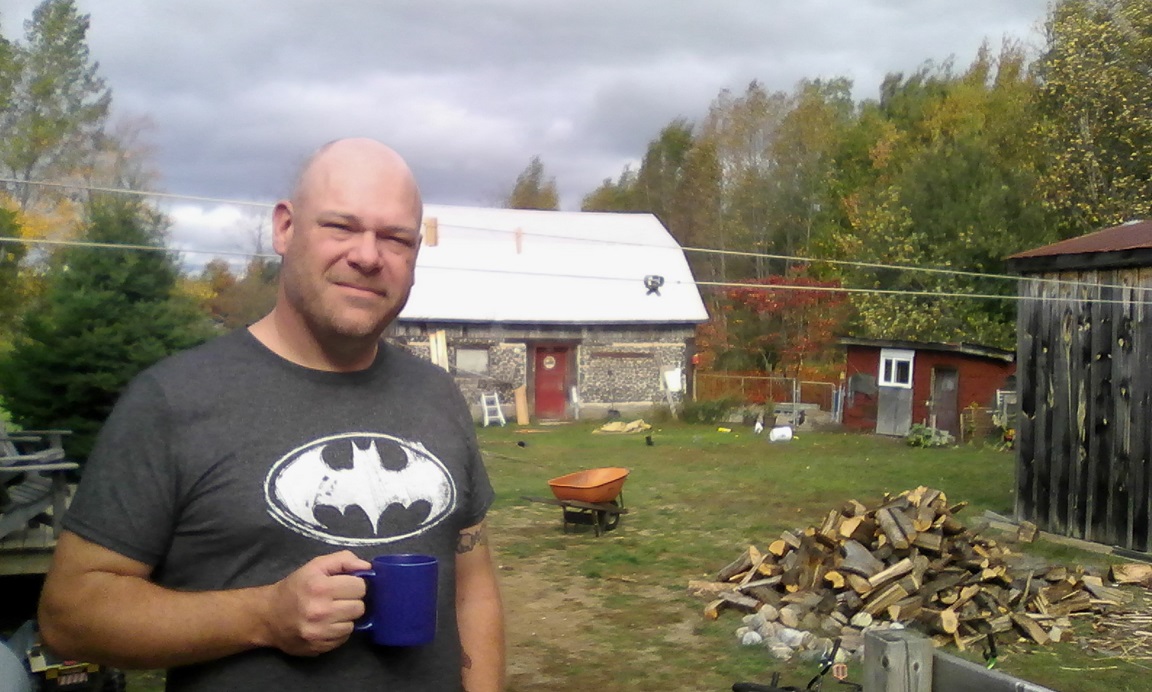 figured. Commuter suburbs. I looked up, and there was a burly, slightly alarmed face looming over me. But no bad vibes. Josh thought I might have died, his wife Lori told me later, laughing. I protested and started to get up. “Come in for a coffee. Have you eaten?” I didn’t want to impose. “No thanks. I have nuts and a sandwich. I’ll get on my way.” “No, no! Come in and warm up.” I relented, as it was a nippy 7 degrees and I’d just been cycling through drizzle. I asked about Christian Island. “Never been. Keep meaning to go."
figured. Commuter suburbs. I looked up, and there was a burly, slightly alarmed face looming over me. But no bad vibes. Josh thought I might have died, his wife Lori told me later, laughing. I protested and started to get up. “Come in for a coffee. Have you eaten?” I didn’t want to impose. “No thanks. I have nuts and a sandwich. I’ll get on my way.” “No, no! Come in and warm up.” I relented, as it was a nippy 7 degrees and I’d just been cycling through drizzle. I asked about Christian Island. “Never been. Keep meaning to go."
Josh is a prison guard in Penetang (no one bothers with the ‘shene), with two sons, Thruxton (a Triumph motorcycle) and Norton, chips off the motorcyclist block. A huge, woody home, with beams, walls and ceilings from reclaimed old buildings, A home with a local history. Josh showed me the cord construction barn out back, made with cords of wood, sawed for burning, but instead, stacked with cement to make walls that last forever and insulate like stone walls.
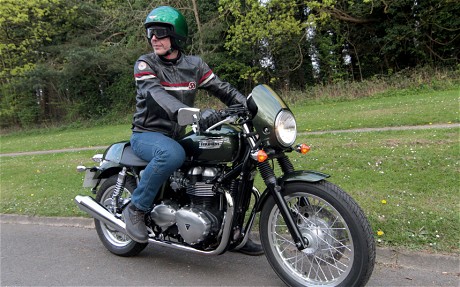 Refreshed in body and spirit, I got up to go. “I can take you and your bike if you are tired.” I was tempted, but that would be cheating. This is a pilgrimage. It demands some penance. The wind was as strong as ever. I needed a few more stops for nut fuel. Funny, it was only cold when I stopped, but my jacket was open most of the way, sometimes back in the basket, so my jacket and I could dry off.
Refreshed in body and spirit, I got up to go. “I can take you and your bike if you are tired.” I was tempted, but that would be cheating. This is a pilgrimage. It demands some penance. The wind was as strong as ever. I needed a few more stops for nut fuel. Funny, it was only cold when I stopped, but my jacket was open most of the way, sometimes back in the basket, so my jacket and I could dry off.
The island was tranquil, a dirt main street in the village of 614. A ferry worker, Tim, told me how they caught some of the 15,000 cottagers subleasing their cottages on AirB&B and put a stop to it. “Ya, they take your land and then make interest on the capital. It should be yours!” I griped. Out in the wind on the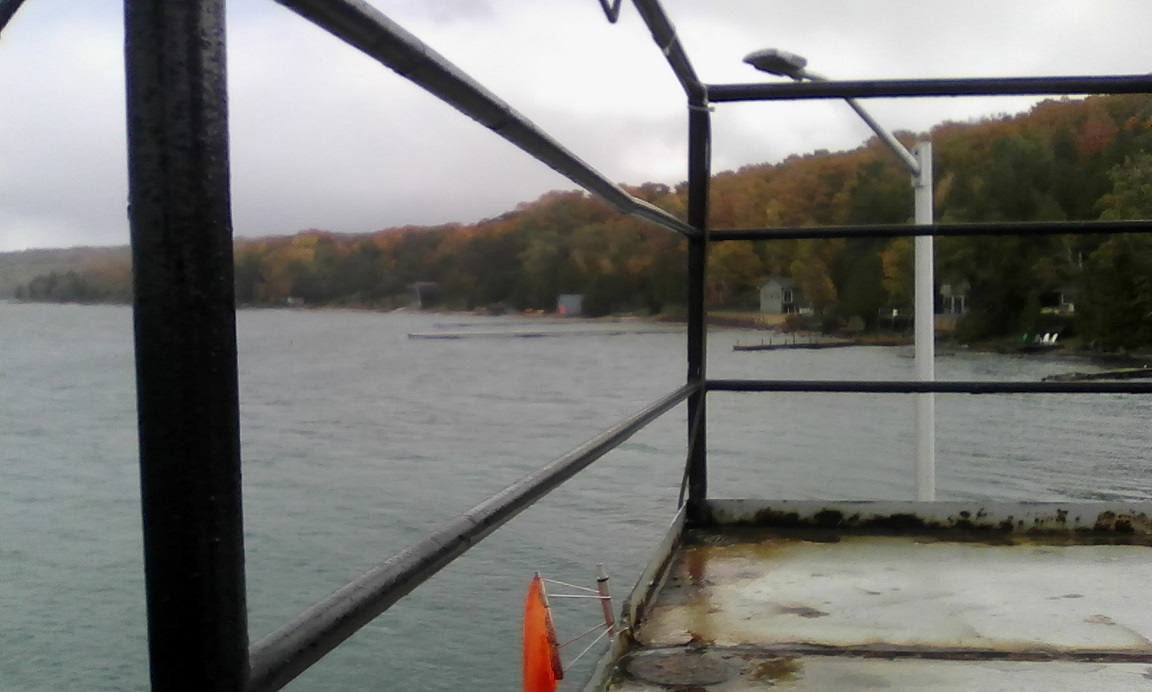 top deck, a cottager, Jeff, spoke with me, telling me “It’s a magical place. I’m so grateful the natives let us come here.” Hmmm, almost as if my bile had reached him by ESP. A nice ‘magical’ moment.
top deck, a cottager, Jeff, spoke with me, telling me “It’s a magical place. I’m so grateful the natives let us come here.” Hmmm, almost as if my bile had reached him by ESP. A nice ‘magical’ moment.
Christian Island was an island of peace and simplicity in comparison. The villagers are descendants of those Ojibwe who survived the smallpox, famine, wars, settlers, and who were first sent packing to Beausoleil Island, the largest island (8 km long) in Georgian Bay Islands National Park further east. It was argued that the soil was too poor, so the natives were moved to the smaller, woe-begotten Christian Island. But in reality, it was just too nice a spot for happy campers. And so was the land of the Chippewas’ Coldwater Reserve on the mainland. They were all dumped on Christian Island in the mid-19th century, as the tidal wave of British immigrants, hungry for land, swamped them.
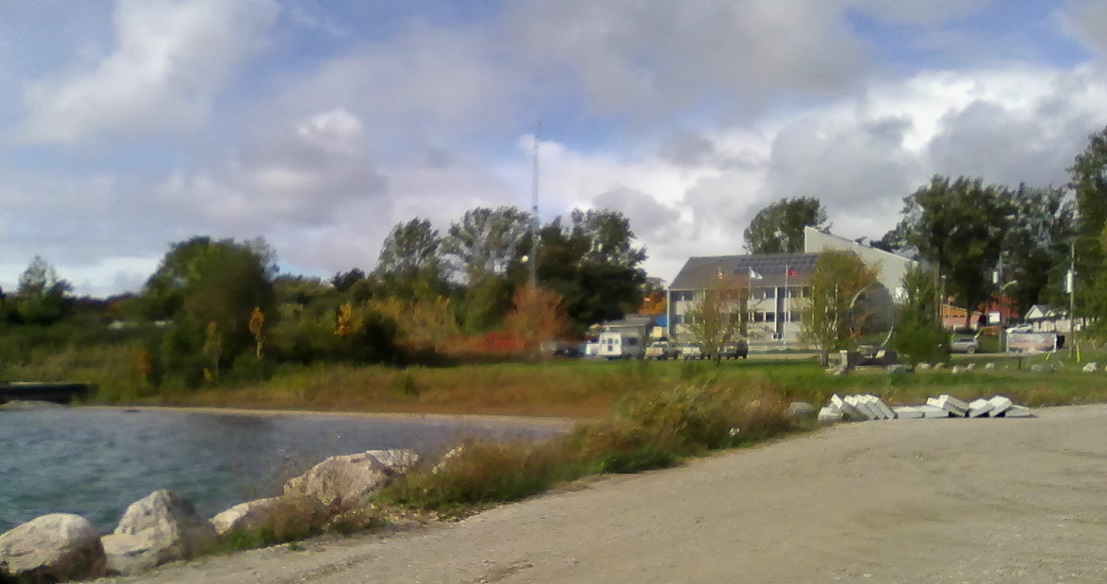
The cottagers on Christian Island are tucked away in 3 hamlets, out of site. There is an archeological dig for Fort Ste Marie II, a small fort built there but abandoned in 1650, excavated by the London Museum of Archeology. Also the spiffy Community Center, a United Church, and a war memorial -- despite the horrible things we whites have done to them, the natives were serious about ‘defending Canada’ in both world wars.
Tim had suggested that as I didn’t have much time, I should go to the lake just north of the village. “Just look for the wooden fence and turn left.” I thought that a bit vague, but now, I realize, there are no fences there, that the collapsing wooden posts stood out. When I reached the lake, it was still and pristine. No cottages, no litter, just a tattered gazebo and fire pit. Returning to catch the ferry back, a woman bundled up against the wind greeted me cheerfully, the first and only time on my trip that anyone, let alone a woman, greeted me spontaneously. Jeff had warned me, “The natives are so hospitable. You will love it.”
The 65-year-old ferry, the M.V. Sandy Graham, purchased by the government in 1998, was very much the worse for wear. "Our people have to cross day to day to get access to all the goods and services, as well as hospitals, medical appointments. I, in good conscience, can't continue to sail this ferry knowing that tragedy could happen out on that water," Christian Island Chief Roly Monague said.***
The only back-up is the feisty Indian Maiden, for passengers only, which can push through ice, keeping the lines of communication 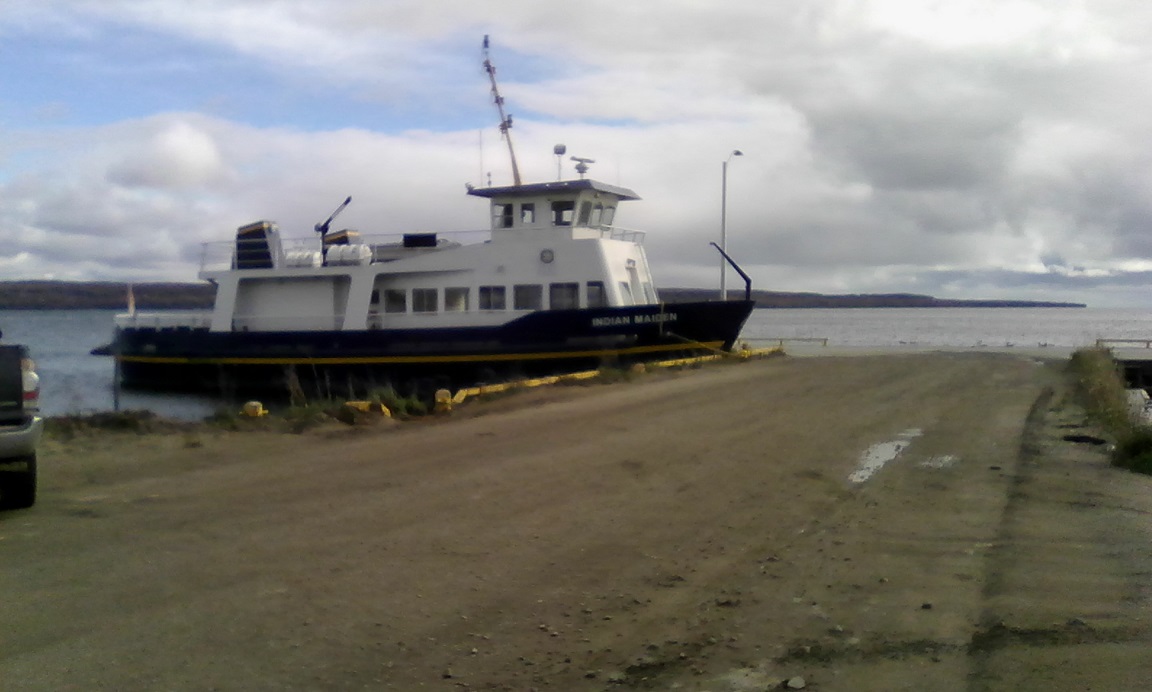 open almost all year round. The Sandy Graham only operates from April to November. When I returned, a huge truck trailer took 20 minutes to back onto the ferry. I asked Tim, “Do you charge six times the price for him? “No, he goes for nothing. He brought over the materials for our new fire hall.”
open almost all year round. The Sandy Graham only operates from April to November. When I returned, a huge truck trailer took 20 minutes to back onto the ferry. I asked Tim, “Do you charge six times the price for him? “No, he goes for nothing. He brought over the materials for our new fire hall.”
The return trip was breathtaking. I was fighting rain most of the time on my trip, but the sun literally poured through clouds, beaming down like a biblical vision. The 270 degree vista spanned the passage between Christian and Beckwith islands, the strait to the peninsula, Gloucester Bay and Midland to the northeast, and the strait to Nottawasaga Bay, Owen Sound and the Bruce peninsula to the southwest.
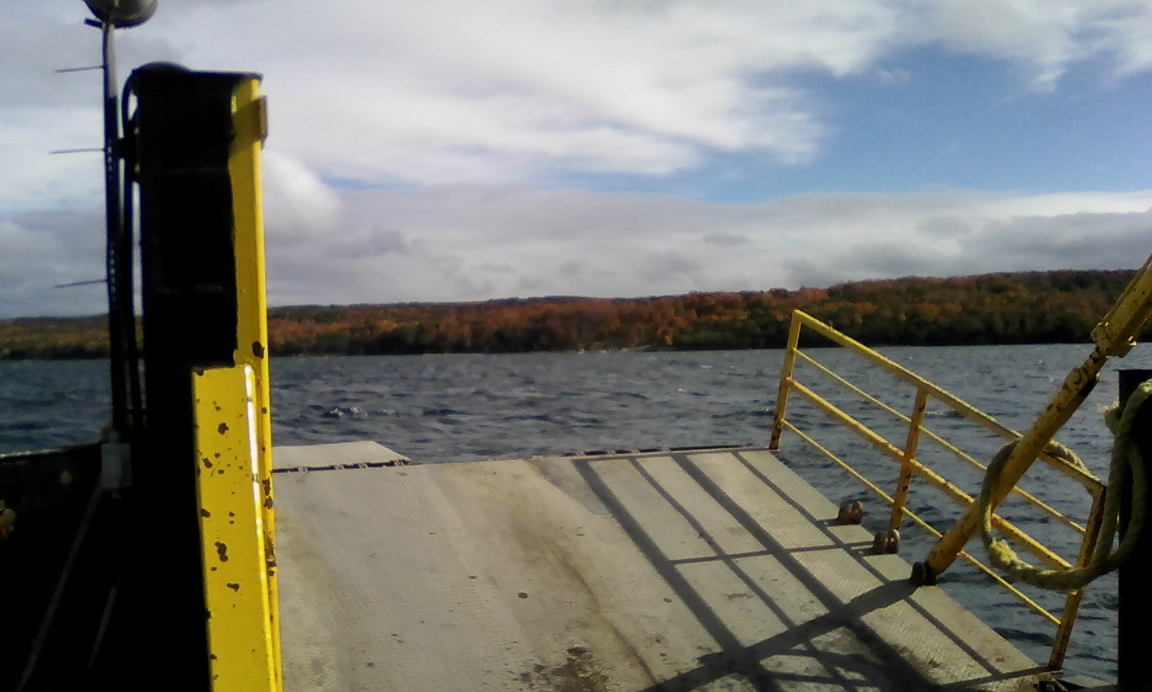 I stopped off at Josh’s place on the way back. “Take Lori, Thruxton and Norton before the trees drop all their leaves. It’s like a monumental garden, full of yellow, green, orange and red blossoms.” I hope he does. I know that would stick as a childhood memory for me. A camera can’t capture that experience. “I wish I could spend the whole day just walking around on deck, looking at the clouds, the water, the islands, the mainland,” I told Thruxton.
I stopped off at Josh’s place on the way back. “Take Lori, Thruxton and Norton before the trees drop all their leaves. It’s like a monumental garden, full of yellow, green, orange and red blossoms.” I hope he does. I know that would stick as a childhood memory for me. A camera can’t capture that experience. “I wish I could spend the whole day just walking around on deck, looking at the clouds, the water, the islands, the mainland,” I told Thruxton.
Uber Uber Alles!
My couchsurfing host John took me to his local pub/ gathering spot, Surf Family Restaurant, where 7 musicians (guitar, mandolin, violin, harmonica). All -- age 60+ baby boomers playing old favourites like CCR’s “Fortunate Son”, Steve Earl’s “Copperhead Road”, the Beatles “Back in the USSR”. I realized the anti-war generation is alive and well, braving the acid rain of neoliberalism, with a smile and a song. Living in the sticks 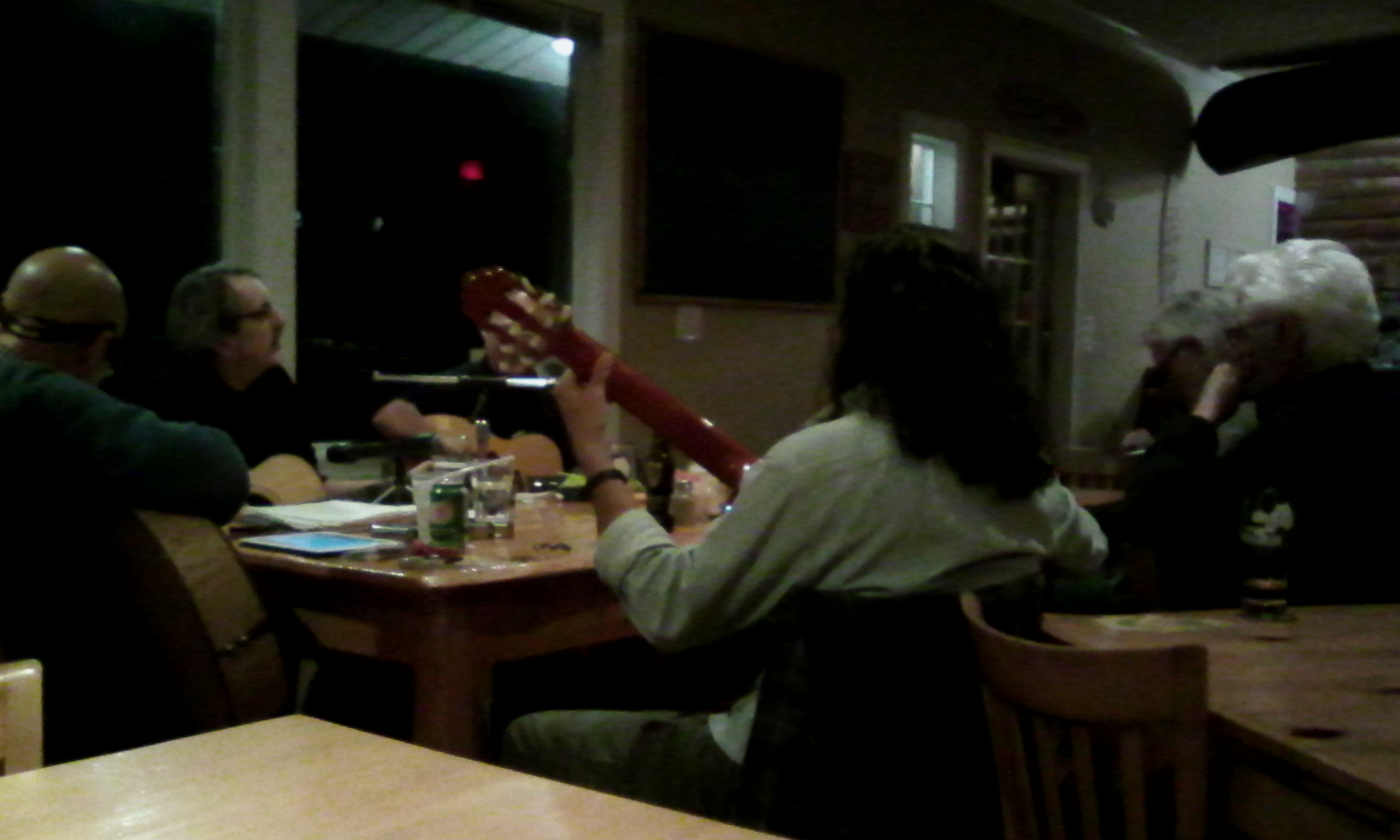 means you have to cultivate your own talents to keep away braindeath. John joined in, and later played at home for Les. I had to tell him the chords of “happy birthday”. Not a guitar hit, I guess.
means you have to cultivate your own talents to keep away braindeath. John joined in, and later played at home for Les. I had to tell him the chords of “happy birthday”. Not a guitar hit, I guess.
The trip back to Barrie was beautiful, fall colours bring the otherwise staid farmland to life. But always in the back of my mind, especially when the noise of cars was absent, this was all inhabited for thousands of years, if lightly. One of the many historical plaques, in Perkinsfield, actually acknowledged that this was the former Wendat Confederacy, now known as Huronia. Well, why are there virtually no natives to be seen, nothing left of a thousand years of life? How did all this land fall into European hands? When are we going to do more than thank the natives at our own festivals for giving them everything, with very little in return? Millions of dollars doesn’t cut it. The natives lived in a paradise, in harmony with nature, without money, private ownership, guns, alcohol.****
The old rail trail is actually a skidoo trail and very patchy, though more rideable (less gravel) than the Orillia and Bruce County trails. Careful use of the biking map is vital, as the trail is broke by Private Property at a few key spots. I ended up on # 93, the main highway by mistake, but lived to tell the tale. Other times, where the traffic was light, I switched to the road, as it takes half the manpower.
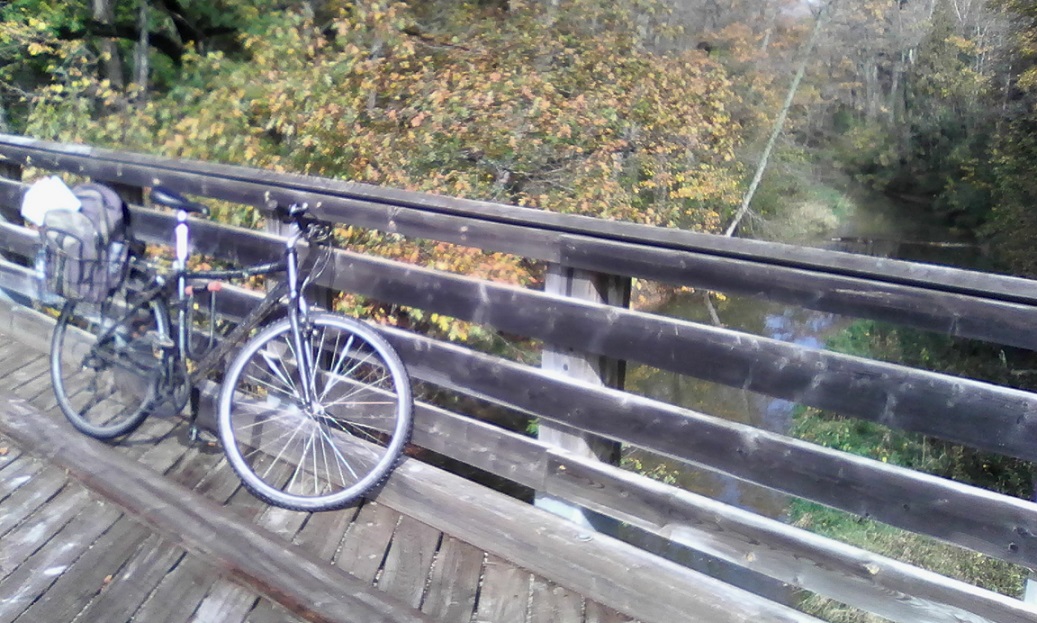 It struck me in Wyevale (not to be confused with Wyebridge), as I crossed an old wooden bridge, that this was the vital artery for the Huron for a thousand years, linking them with a trade route that reached the Bay of Mexico, and then for proto-Canada in the war of 1812, when Lord Simcoe made his name fighting the Yankees. Britain was terrified that the Yanks would invade through Detroit and Niagara and cut off the lifeblood of ‘Canada’, the Great Lakes. The alternate route was up through Lake Simcoe via a portage to the River Wye and on to Penetanguishene, the first site for a port on Georgian Bay.
It struck me in Wyevale (not to be confused with Wyebridge), as I crossed an old wooden bridge, that this was the vital artery for the Huron for a thousand years, linking them with a trade route that reached the Bay of Mexico, and then for proto-Canada in the war of 1812, when Lord Simcoe made his name fighting the Yankees. Britain was terrified that the Yanks would invade through Detroit and Niagara and cut off the lifeblood of ‘Canada’, the Great Lakes. The alternate route was up through Lake Simcoe via a portage to the River Wye and on to Penetanguishene, the first site for a port on Georgian Bay.
Then came the railroad, planned in 1871, finished in 1879. The naissant Midland started to expand in anticipation, as the roads were rough, the water not enough for the needs of modern capitalism. By the 1890s, a little more than a decade, most of the lumber had been clearcut and carted off by rail. By the early 20th century, steamships were being built in Midland, the grain was flowing from the Prairies, the trains moving. Imagining what life was like then helped fill the 5 1/2 hrs of cycling. A more civilized version of the Wild West, but a flash in the historical pan, a lifespan of a mere 80 years.
Train service finally died in 1958 and the tracks were ripped up in 1997. No more furs, trees, no need for trans-shipping with the St Lawrence seaway, no need to build steamships … Sainte-Marie-au-pays-des-Hurons died another death, as industrial society ebbed, jobs now only in service and trucking/ construction.
The car-truck era took over. Noisy, smelly, polluting, petty, egotistic, antisocial, dangerous for everyone/thing, bipedal, winged, four- or hundred-footed. I saw more than one furry creature crawling optimistically out on the highway.
Public transit doesn’t exist in the outback. John takes advantage of this. A fine photographer, he prefers to Uber than hustle for wedding shots. He explained: “Innisfil decided to team up with Uber sharing, instead of taxis. The township subsidizes Uber so that the passengers pay $3 for a normal ride.” One bus would have cost $275,000 a year. The city has agreed to pay Uber $125,000 in 2018.
Manjot Saini, the owner of Global Taxi in Innisfil, told the Toronto Star, “It has been really frustrating. To be honest, we’re thinking about slowly taking our cabs out, one by one. I can’t compete with Uber and still pay my fees to the town.” On the upside, the data amassed will be used to determine possible routes for actual buses.This novel idea has attracted the attention of other neoliberal, suburban sprawls. The New York Times and BBC were fascinated with Innisfil and predicted this policy to be the wave of the future.
The march of capitalism + technology. But Uber backlash is growing -- its crass, greed-fueled, tax-dodging ways prompted Denmark to ban it outright. The European Court ruled Uber is a (taxable) transport company and must pay up.
Uber threatens the livelihood of the latter day ‘natives’. A bit like what the British/ Iroquois did to the Huron 400 years ago with their hi-tech guns. John sees the upside for today's coureurs de bois: “I can go anywhere in the world, click ‘available, and with my GPS, start working. But we Uberists are not workers. We’re really self-employed businessmen.” Wow. Will the world soon be ‘capitalists only’? No need for workers?
I teased John: “You know the ultimate Uber will be driverless.” “Not yet,” he replied defensively. But John is already adapting to the post-industrial world, where Midland is right where its name suggests -- smack in the middle of Canada's future: a service economy via the internet. Its version of colonial-style slash-and-burn and dispossession of natives is faceless. Hopefully, younger nations like Israel, intent on following the colonial path, will learn from our experience, and start to respect and cherish their natives.





